Larry Ross has held a lifelong connection with the sciences and visual arts. Trained as a urologist and having taught and practiced medicine for a number of years at UIC in the College of Medicine, Ross is the Clarence C. Saelhof Professor Emeritus in the Department of Urology. In addition to his professional practice, Ross has extensively travelled and documented day-to-day human experiences in Bhutan, Cuba, Japan, Morocco, Nepal, Peru, and Vietnam. This week the COMP Magazine caught up with Ross to discuss his early encounters with the arts, how his scientific investigations impact his documentary practice, the importance of immersing oneself in the lives of the subject during travels, and his body of work, “Riberenos: The River People of the Peruvian Amazon”.
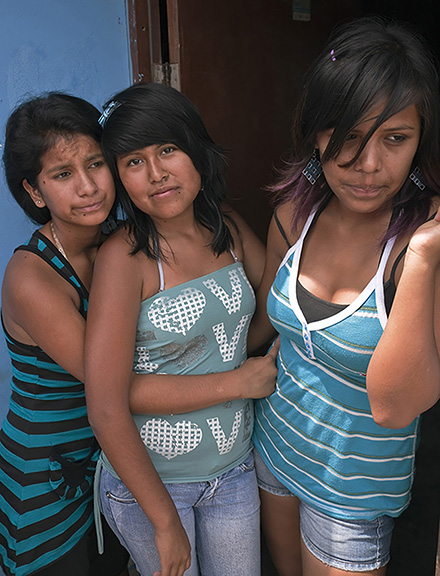
Larry Ross, Shanty Town Teens, Lima, Peru, 2010
You are a urologist by profession. Yet, you come from a family of artists, and studied drawing and painting at the Art Institute of Chicago. Also, you studied photography at Columbia College Chicago. I believe with Matt Siber? I’m wondering if you can identify any specific events or items that inform your current efforts in photography?
My interest in art began long before my decision to pursue medicine. I come from a family of artists, including my mother, an oil painter, and my sister, a painter and interior designer. I always enjoyed drawing and sketching, and my parents sent me to the Art Institute of Chicago to study drawing and painting. During medical school and early in my career I used my art training to illustrate journal articles and book chapters and continued to draw and paint for relaxation.
While still in high school I began to explore photography and learned to develop and print my own images. Ultimately, I migrated to photography as my primary artistic expression. As my career in medicine progressed and took me all over the world, photography allowed me to capture images with ease.
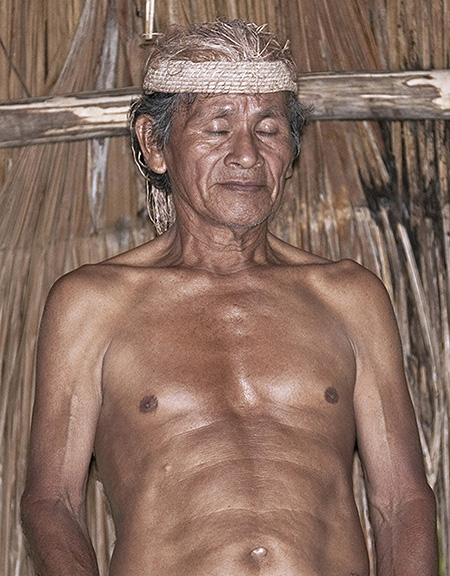
Larry Ross, Shaman at Prayer, Amazon River jungle village, 2010
When I look at your work I see connections between anthropology and documentary photography. Though anthropology resides in the social sciences, I believe your practice is informed by studies in the sciences. Can you describe how you see the arts and sciences intersecting?
I believe that there are aspects of “science” in art. Painters learn to mix pigments in water or oil; to apply them with brushes or other tools on paper or canvas and produce an image. Sculptors manipulate clay or weld metals to produce three-dimensional works of art that can be realistic or highly abstract.
Photography is a scientific art form. Film photography requires learning the chemistry of silver emulsions, the effects of light on the media and the chemicals and reagents necessary to bring an image to life on paper. Photographers need to understand the science of optics to choose lenses that capture their artistic visions. Digital capture is a science that allows photographers to make and manipulate their images in ways never possible with traditional film-based technology.
Many physicians become artists. Perhaps it is the combination of the hard sciences and social sciences required to treat both the diseases and psycho-social needs of our patients that draws us to the arts.
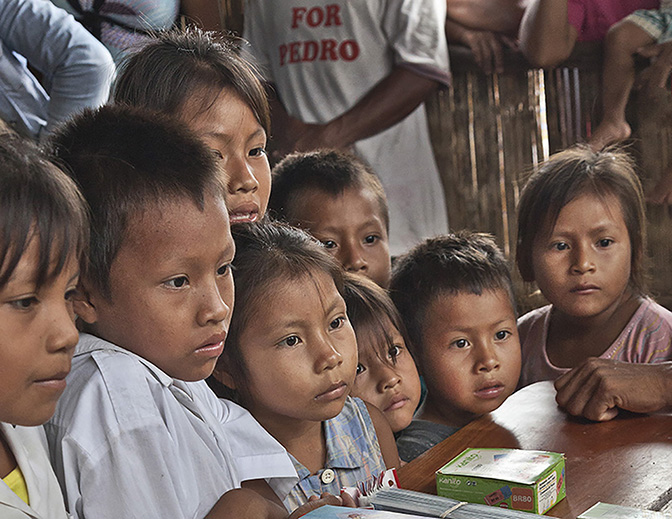
Larry Ross, School Children with gift of Pencils and Paper, Amazon River jungle village, 2010
It’s fairly common to make pictures during travel. However, you tend to focus intensely on specific places like Bhutan, Nepal, Cuba, etc. In part these series are visual documents of the quotidian while noting distinct differences in cultures. Can you walk us through your selection of sites and discuss your process for approaching your subject?
I am a second generation American, and through my foreign-born grandparents and other relatives, I have always felt my immigrant roots. My parents worked hard so that I could become a physician and achieve a quality of life never imagined by my grandparents’ generation.
As an academic physician I have been privileged to travel the world and meet people in diverse cultures, many underdeveloped by western standards. As a photographer I have chosen to focus on these cultures, to learn about them and collect images that try to convey my impressions of the “place” and the “people”.
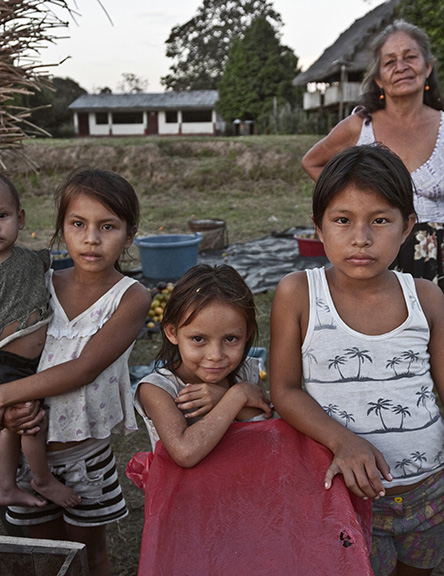
Larry Ross, Sisters and Grandmother, Amazon River jungle village, 2010
Let’s discuss your series Riberenos: The River People of the Peruvian Amazon. You note the emergence and transition of this area. Why did you select this culture? Over what period of time were the photographs made? Were there any interesting encounters you can share?
For years I read about primitive cultures that existed in the tropical rain forests of the Amazon River basin. Many years ago, I trained a urology resident from Columbia and discussed with him the possibility of an Amazon River trip to photograph the people. He discouraged me because political dissidents in the country at that time were kidnapping westerners on the river for ransom.
I was in Peru seventeen years ago to photograph Machu Pichu and the Galapagos islands. A communist insurgency prevented travel on the Amazon for similar reasons. Eight years ago, after defeat of the communists, I was able to return to the Peruvian Amazon. I spent nine days on the upper Amazon traveling each day into the local villages of the Cocama Indians, and two days in the shanty towns of Lima where some children of the indigenous people are sent to obtain better education.
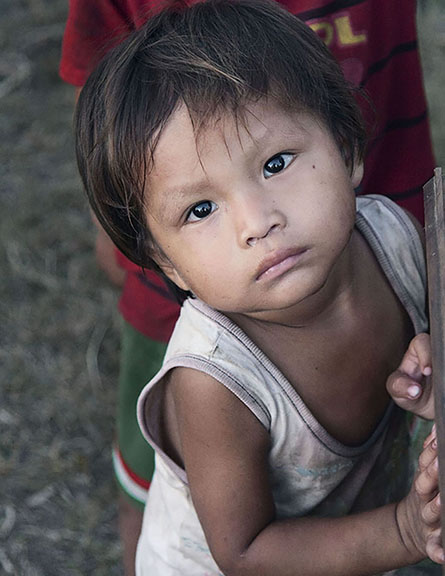
Larry Ross, Child, Amazon River jungle village, 2010
My guide was a young Cocama man from a family of eight children whose parents allowed a Catholic priest to take him to Lima when he was eight years old for education. He returned to the jungle after finishing college to work for the government jungle conservation program, and later, to guide travelers.
These Cocama descendants were first encountered by Spanish invaders in the 1500s. They are totally self-sufficient: hunting game, fishing, and foraging jungle fruits and edible plants. For shelter they build wood and thatched huts which last a year or two and have to be rebuilt after the spring flooding. At the time I was there they had no communication system and travel was by dugout canoe or wooden rafts. The government provides jungle schools with teachers who volunteer to spend six months teaching Spanish (the indigenous natives speak Quechua, an Incan language) and basic reading and writing skills. Intermittently, the government sends nurses to small primitive clinics along the river, but medical care is unreliable, and people depend on treatment by Shamans with herbal remedies and prayer.
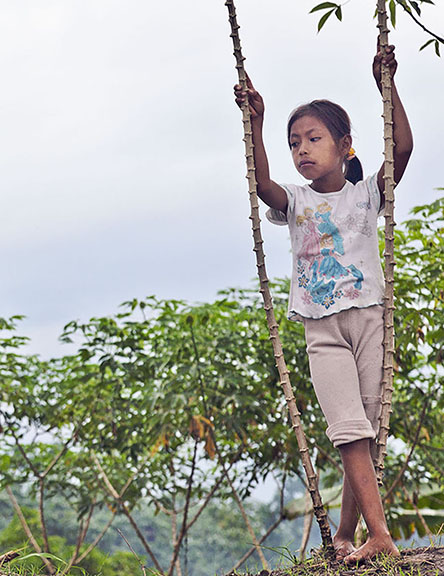
Larry Ross, Child in Disney T-shirt, Amazon River jungle village, 2010
The most interesting encounter occurred when the guide convinced the young “mayor” of a village to bring his wife aboard our boat. He had seen the boat on the river but was afraid to visit. He had to be convinced by an elder in the village who said he was not afraid to come and would bring his wife and grandchildren as well. I was asked to take him to our cabin for a tour. He had never seen a toilet or shower stall. When I tried to explain their use and flushed the toilet, he ran out of the cabin in fear that he would be injured. When the guide tried to explain the use of the shower and toilet the “mayor” said that they must be “used by the white people to rid themselves of evil spirits”.
Later we all gathered on the boat deck and the crew brought out beer and snacks. The guide urged us to exchange questions which he would translate. We learned that intermittent government medical clinics on the river would provide birth control pills to native women who don’t wish to have the very large families of their ancestors. However, the supply of medicines would run out and the nurse volunteers would not come back for long periods of time. We noted that the “mayor” only had two children and asked his wife how she managed to have such a small family when the clinic could no longer supply her birth control pills. She smiled and crossed her legs. Everyone began to laugh. The “mayor” and elder were told I was a doctor and asked what I treated. I explained what a urologist does including male sexual function issues. Their eyes brightened, and they asked if there was treatment that worked, and could I explain it. They then had a rapid exchange with the guide who began to laugh. I asked what was so funny and he said the “mayor” invites you to “stay in his village for a few months. He will take you in his canoe from village to village and you will become a very rich man!”
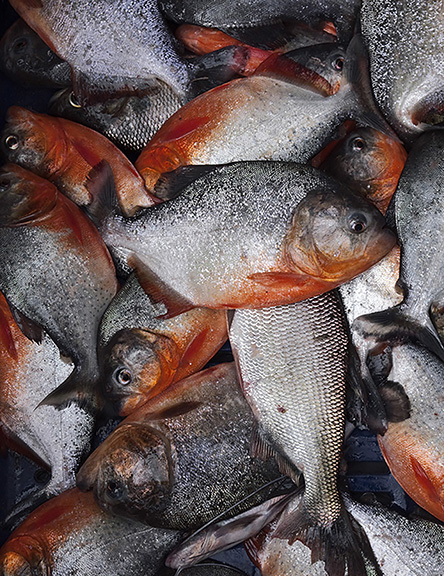
Larry Ross, River Bounty, Amazon River jungle village, 2010
In the work I have seen, the focus is upon places outside the United States. I’m wondering about the issue of being an outsider documenting unfamiliar subjects. This has been a tricky area for photographers since inception of the medium. What do you see as important in portraying your subject? How do you deal with the issue of integrity and honesty?
Artists often face the issue of portraying people of cultures other than their own, or even people of different religious, ethnic, racial, socioeconomic, or sexual orientation living in their own country. In my early photography practice, I thought that images of the landscape and architecture told the story of these countries and cultures. But I quickly learned that it was the everyday people who were the key to trying to understand the “place” rather than just the towns they built, or the geography they inhabit.
What is most important to me in my work is to find guides who are of the culture, able to connect me to the local citizens, and help me to interact with them. I always try to engage people to tell me about themselves, and I always ask permission to photograph them. When possible, I ask for an email address and offer to send them an image I have taken of them.
I have relied on digital capture for over ten years which has made interactions with my subjects interesting as I can show them their images when I am done. In my work on the Peruvian Amazon, the people had no mirrors and had seen themselves only in their reflections in the river. When I showed them their images on the camera screen the reactions varied from disbelief to laughter and delight, to one old man asking if I could take the image out of the camera and give it to him.
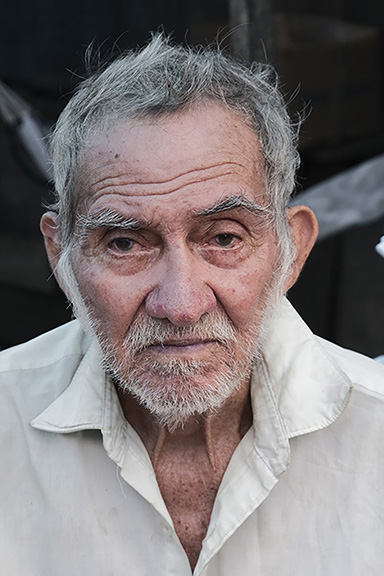
Larry Ross, Old Man, Amazon River jungle village, 2010
What do you value most in your photography practice?
Photography has allowed me to pursue my art and has reinforced what, as a physician, I have always believed. There is a universality to the human experience. Disease does not discriminate by ethnicity, skin color, religious belief, socioeconomic status, or sexual orientation.
I have been able to display my art in the clinical spaces where I and others care for our patients. Patients remark about enjoying the images and colleagues and friends have requested and received some of the art for their collections. My large exhibition of the Riberenos resulted when a patient referred by a Spanish colleague approached me and asked if he could share some of the images with the Consul General of Peru. The patient was the Director of Instituto Cervantes in Chicago and was planning a program to highlight Peruvian culture with sponsorship of the Consul General. I was asked to prepare an exhibit at Instituto Cervantes for a gallery currently displaying original works by Goya and Dali, on loan from Spain.
I was excited to accept this invitation and this experience has stimulated me to continue my photography practice. My near total retirement from medicine will give me the time to continue my life long work as an artist.
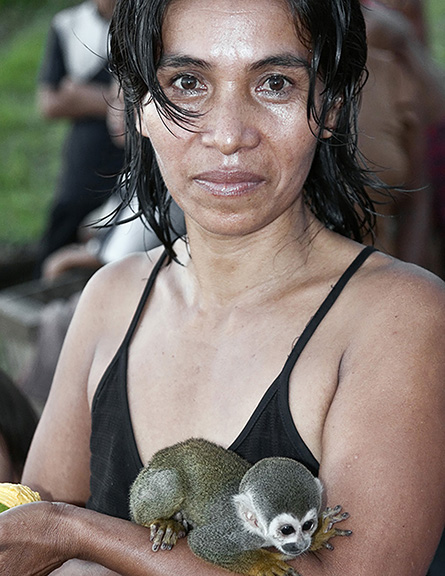
Larry Ross, Fruit Seller with Monkey, Amazon River jungle village, 2010
I trust you are preparing for another excursion. Do you have any upcoming travel plans? What are you currently working upon? What’s the plan for the remainder of 2018?
I have been concerned for many years about climate change. One of the many animal species affected is the polar bear. In November I am planning a trip to Churchill, Canada in northern Manitoba where guides will take us to the area where the bears can be seen and photographed before they attempt to get on the winter ice floes that allow them to hunt prey further into the Artic.
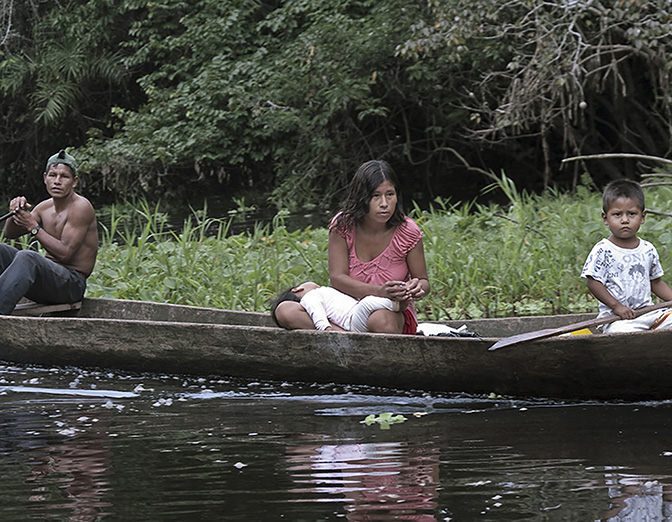
Larry Ross, Transport, Amazon River jungle village, 2010
For additional information on the photographic practice of Larry Ross, please visit:
Larry Ross – www.photodocimages.com
Your Shot – http://yourshot.nationalgeographic.com/profile/74595/#/gallery/978301/
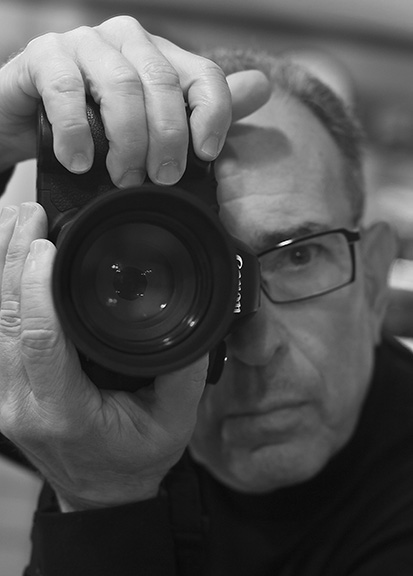
Larry Ross, self-portrait, n.d.
Artist Interview by Chester Alamo-Costello


